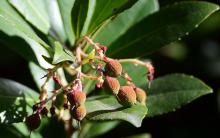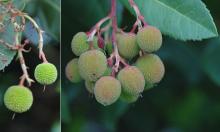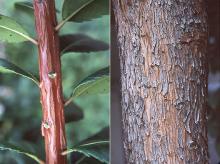Arbutus unedo
Common name:
Strawberry Tree
Killarney Strawberry Tree
Madroño
Pronunciation:
ar-BU-tus U-ne-do
Family:
Ericaceae
Genus:
Type:
Broadleaf
Native to (or naturalized in) Oregon:
No
- Evergreen shrub/tree, 8-12(35) ft [2.4-3.6(10.6) m] tall, similar width; red-brown attractive bark, shaggy. Leaves simple, alternate, elliptic-oblong to elliptic-ovate, 5-10 cm long, tip acute, base wedge-shaped (cuneate), margin serrate, glossy dark green above, glabrous, paler below; petiole, 6 mm long, glandular, red. Flower urn-shaped, like blueberry, 6 mm long, white to pinkish, in clusters (panicles) about 5 cm long; blooms in winter or early spring. Fruit, spherical orange-red ("strawberry-like"), about 1.5-2 cm across, matures in fall. (In western Oregon, the flowers start to form in late summer and are in full bloom when the fruit, initiated the previous year, begins to ripen.)
- Full sun, well-drained, acid to neutral soil. No summer water needed when established (good tap root). Does not flourish in a humid climate. Can be trained as a tree to emphasize bark, but more sensitive to winter kill.
- Hardy to USDA Zone (6)7 Native from southwestern Ireland to the Mediterranean region. A. andrachne is known at the Grecian Strawberry Tree, it resembles A. menziesii but smaller.
- The fruit is edible when fully ripe, but it's gritty and lacks flavor. Jacobson (1996) points out that the specific epithet unedo is from the Latin unum edo meaning "I eat one". Suggesting that the fruit is so poor tasting that a person would not eat more than one. However, it "rather surprisingly, produces excellent jellies and jams, and its high pectin content gives rapid setting without additives". The product has a pronounced 'strawberry' taste" (Mabberley, D.J., and P.J. Placito. 1993. Algarve Plants and Landscape, Oxford Univ. Press). This source also indicates that in Portugal a distilled sprit (a brandy) is made from the fruit of Arbutus unedo, called aguardente de medronhos (sometimes, medronheiro). Fruit is harvested between September and November and placed in open-topped barrels (vasilhas) and water added to start the fermentation. To prevent a second fermentation (i.e., vinegar) a layer of mud (adobe) is put over the top to exclude oxygen. After 3-4 months the mass is transferred to a copper still, boiled and evaporated alcohol condensed and collected. "Better qualities of medronho undergo multiple distillations". Usually, at least in the province of Algarve, the medronho is sold to licensed bottling companies who mix it with alcohol and "various essences". Export is forbidden, possibly because the product contains too much methanol.
- Oregon State Univ. campus: east of Ocean Administration (near 26th and Monroe).
Click image to enlarge












